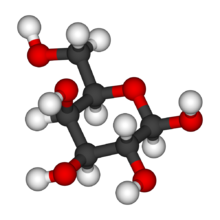Galactose
Appearance

| |||
| |||
| Identifiers | |||
|---|---|---|---|
| |||
3D model (JSmol)
|
|||
| ChEBI | |||
| ChEMBL | |||
| ChemSpider | |||
| KEGG | |||
| MeSH | Galactose | ||
PubChem CID
|
|||
| UNII | |||
| |||
| Properties | |||
| C6H12O6 | |||
| Molar mass | 180.16 g·mol−1 | ||
| Appearance | White solid[1] | ||
| Odor | Odorless[1] | ||
| Density | 1.5 g/cm3[1] | ||
| Melting point | 168–170 °C (334–338 °F; 441–443 K)[1] | ||
| 650 g/L (20 °C)[1] | |||
| -103.00·10−6 cm3/mol | |||
| Pharmacology | |||
| V04CE01 (WHO) V08DA02 (WHO) (microparticles) | |||
| Hazards | |||
| NFPA 704 |
| ||
Except where otherwise noted, data are given for materials in their standard state (at 25 °C [77 °F], 100 kPa). | |||
| Infobox references | |||
Galactose (from the Greek stem γάλακτ– galakt–, "milk") is a sugar. It has almost the same chemical structure as glucose.
Large amounts of pure galactose do not exist in nature. Instead, galactose is usually found with glucose in lactose, a sugar found in milk and other milk products. After lactose is digested and absorbed, galactose arrives in the liver. There it is changed into either glucose or glycogen.
References
[change | change source]



